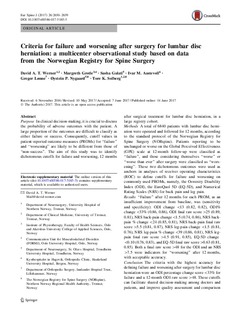| dc.description.abstract | Purpose In clinical decision-making, it is crucial to discuss the probability of adverse outcomes with the patient. A large proportion of the outcomes are difficult to classify as either failure or success. Consequently, cutoff values in patient-reported outcome measures (PROMs) for “failure” and “worsening” are likely to be different from those of “non-success”. The aim of this study was to identify dichotomous cutoffs for failure and worsening, 12 months after surgical treatment for lumbar disc herniation, in a large registry cohort. Methods A total of 6840 patients with lumbar disc herniation were operated and followed for 12 months, according to the standard protocol of the Norwegian Registry for Spine Surgery (NORspine). Patients reporting to be unchanged or worse on the Global Perceived Effectiveness (GPE) scale at 12-month follow-up were classified as “failure”, and those considering themselves “worse” or “worse than ever” after surgery were classified as “worsening”. These two dichotomous outcomes were used as anchors in analyses of receiver operating characteristics (ROC) to define cutoffs for failure and worsening on commonly used PROMs, namely, the Oswestry Disability Index (ODI), the EuroQuol 5D (EQ-5D), and Numerical Rating Scales (NRS) for back pain and leg pain. Results “Failure” after 12 months for each PROM, as an insufficient improvement from baseline, was (sensitivity and specificity): ODI change <13 (0.82, 0.82), ODI% change <33% (0.86, 0.86), ODI final raw score >25 (0.89, 0.81), NRS back-pain change <1.5 (0.74, 0.86), NRS back-pain % change <24 (0.85, 0.81), NRS back-pain final raw score >5.5 (0.81, 0.87), NRS leg-pain change <1.5 (0.81, 0.76), NRS leg-pain % change <39 (0.86, 0.81), NRS leg-pain final raw score >4.5 (0.91, 0.85), EQ-5D change <0.10 (0.76, 0.83), and EQ-5D final raw score >0.63 (0.81, 0.85). Both a final raw score >48 for the ODI and an NRS >7.5 were indicators for “worsening” after 12 months, with acceptable accuracy. Conclusion The criteria with the highest accuracy for defining failure and worsening after surgery for lumbar disc herniation were an ODI percentage change score <33% for failure and a 12-month ODI raw score >48. These cutoffs can facilitate shared decision-making among doctors and patients, and improve quality assessment and comparison of clinical outcomes across surgical units. In addition to clinically relevant improvements, we propose that rates of failure and worsening should be included in reporting from clinical trials. | nb_NO |
| dc.rights.holder | © The Author(s) 2017 Open Access This article is distributed under the terms of the Creative Commons Attribution 4.0 International License (http://creativecommons.org/licenses/by/4.0/), which permits unrestricted use, distribution, and reproduction in any medium, provided you give appropriate credit to the original author(s) and the source, provide a link to the Creative Commons license, and indicate if changes were made. | nb_NO |

